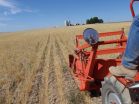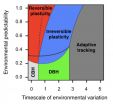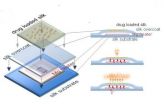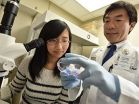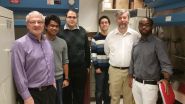Unmanned underwater vehicle provides first 3-D images of underside of Antarctic sea ice
Sucessful test of SeaBed give scientists a powerful tool to study the changes occurring in sea-ice extent
2014-11-24
(Press-News.org) A National Science Foundation (NSF)-funded research team has successfully tested an autonomous underwater vehicle, AUV, that can produce high-resolution, three-dimensional maps of Antarctic sea ice. SeaBED, as the vehicle is known, measured and mapped the underside of sea-ice floes in three areas off the Antarctic Peninsula that were previously inaccessible.
The results of the research were published this week in the journal Nature Geoscience. Scientists at the Institute of Antarctic and Marine Science (Australia), Antarctic Climate and Ecosystem Cooperative Research Centre (Australia), Woods Hole Oceanographic Institution (USA) and British Antarctic Survey (U.K.) jointly carried out the project.
Ted Maksym, an NSF-funded researcher at Woods Hole and co-author of the Nature paper, said the successful SeaBED deployment is an important first step toward making the kinds of routine underwater measurements needed to help monitor and understand large-scale changes in sea ice.
"What this effort does is show that observations from AUVs under the ice are possible and there is a very rich data set that you can get from them," he said. "This work is an important step toward making the kinds of routine measurements we need in order to really monitor and understand what's happening with the ice and the large scale changes that are occurring."
While most oceanographic survey instruments look down at the seafloor, SeaBED's upward-looking sonar allowed it to map under the ice, said Woods Hole engineering scientist Hanumant Singh, whose lab designed, built and operated the AUV.
The AUV operated at a depth of 20 to 30 meters (65 to 98 feet) and was driven in a "lawnmower pattern." These lines of data were merged to form high-resolution 3-D bathymetric surveys of the underside of the ice. The yellow SeaBED robot, which is approximately two meters (six feet) long and weighs nearly 200 kilograms (440 pounds), has a twin-hull design that gives the robot enhanced stability for low-speed photographic surveys.
"Putting an AUV together to map the underside of sea ice is challenging from a software, navigation and acoustic communications standpoint," said Singh.
"SeaBED's maneuverability and stability made it ideal for this application where we were doing detailed floe-scale mapping and deploying, as well as recovering in close-packed ice conditions," he added. "It would have been tough to do many of the missions we did, especially under the conditions we encountered, with some of the larger vehicles."
NSF supported the development and deployment of SeaBED to advance the state-of-the-art of these ocean-going instruments as remote sensors in extreme environments.
Scientists use a range of technologies and techniques to measure sea ice thickness. Satellite observations can measure large-scale thickness from space, but interpreting the data accurately can be difficult due to snow cover on the ice. Measurements made on the sea ice by drilling holes, together with visual observations from ships are critical for building a more complete picture, but difficulties in getting access to thicker areas of sea ice leave gaps in the data. Now, with the SeaBED, scientists have an invaluable new tool to fill this gap.
INFORMATION:
-NSF-
[Attachments] See images for this press release:
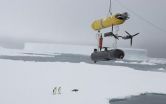
ELSE PRESS RELEASES FROM THIS DATE:
2014-11-24
Coral reefs persist in a balance between reef construction and reef breakdown. As corals grow, they construct the complex calcium carbonate framework that provides habitat for fish and other reef organisms. Simultaneously, bioeroders, such as parrotfish and boring marine worms, breakdown the reef structure into rubble and the sand that nourishes our beaches. For reefs to persist, rates of reef construction must exceed reef breakdown. This balance is threatened by increasing atmospheric carbon dioxide, which causes ocean acidification (decreasing ocean pH). Prior research ...
2014-11-24
LIND, Wash. - In the world's driest rainfed wheat region, Washington State University researchers have identified summer fallow management practices that can make all the difference for farmers, water and soil conservation, and air quality.
Wheat growers in the Horse Heaven Hills of south-central Washington farm with an average of 6-8 inches of rain a year. Wind erosion has caused blowing dust that exceeded federal air quality standards 20 times in the past 10 years.
"Some of these events caused complete brown outs, zero visibility, closed freeways," said WSU research ...
2014-11-24
Researchers from North Carolina State University have created a model that mimics how differently adapted populations may respond to rapid climate change. Their findings demonstrate that depending on a population's adaptive strategy, even tiny changes in climate variability can create a "tipping point" that sends the population into extinction.
Carlos Botero, postdoctoral fellow with the Initiative on Biological Complexity and the Southeast Climate Science Center at NC State and assistant professor of biology at Washington State University, wanted to find out how diverse ...
2014-11-24
Last year, University of Pennsylvania researchers Alexander J. Stewart and Joshua B. Plotkin published a mathematical explanation for why cooperation and generosity have evolved in nature. Using the classical game theory match-up known as the Prisoner's Dilemma, they found that generous strategies were the only ones that could persist and succeed in a multi-player, iterated version of the game over the long term.
But now they've come out with a somewhat less rosy view of evolution. With a new analysis of the Prisoner's Dilemma played in a large, evolving population, they ...
2014-11-24
MEDFORD/SOMERVILLE, Mass. (Nov. 24, 2014, 3 P.M.) -- Researchers at Tufts University, in collaboration with a team at the University of Illinois at Champaign-Urbana, have demonstrated a resorbable electronic implant that eliminated bacterial infection in mice by delivering heat to infected tissue when triggered by a remote wireless signal. The silk and magnesium devices then harmlessly dissolved in the test animals. The technique had previously been demonstrated only in vitro. The research is published online in the Proceedings of the National Academy of Sciences Early ...
2014-11-24
A Jackson Laboratory research team has found that the misfolded proteins implicated in several cardiac diseases could be the result not of a mutated gene, but of mistranslations during the "editing" process of protein synthesis.
In 2006 the laboratory JAX Professor and Howard Hughes Medical Investigator Susan Ackerman, Ph.D., showed that the movement disorders in a mouse model with a mutation called sti (for "sticky," referring to the appearance of the animal's fur) were due to malformed proteins resulting from the incorporation of the wrong amino acids into proteins ...
2014-11-24
Research that provides a new understanding of how bacterial toxins target human cells is set to have major implications for the development of novel drugs and treatment strategies.
Cholesterol-dependent cytolysins (CDCs) are toxins produced by major bacterial pathogens, most notably Streptococcus pneumoniae and group A streptococci, which collectively kill millions of people each year.
The toxins were thought to work by interacting with cholesterol in target cell membranes, forming pores that bring about cell death.
Published today in the prestigious journal Proceedings ...
2014-11-24
A commonly prescribed muscle relaxant may be an effective treatment for a rare but devastating form of diabetes, researchers at Washington University School of Medicine in St. Louis report.
The drug, dantrolene, prevents the destruction of insulin-producing beta cells both in animal models of Wolfram syndrome and in cell models derived from patients who have the illness.
Results are published Nov. 24 in the Proceedings of the National Academy of Sciences (PNAS) Online Early Edition.
Patients with Wolfram syndrome typically develop type 1 diabetes as very young children ...
2014-11-24
(Edmonton) A team of researchers from the University of Alberta has discovered a new approach to fighting breast and thyroid cancers by targeting an enzyme they say is the culprit for the "vicious cycle" of tumour growth, spread and resistance to treatment.
A team led by University of Alberta biochemistry professor David Brindley found that inhibiting the activity of an enzyme called autotaxin decreases early tumour growth in the breast by up to 70 per cent. It also cuts the spread of the tumour to other parts of the body (metastasis) by a similar margin. Autotaxin is ...
2014-11-24
High blood pressure and nonalcoholic fatty liver disease (NAFLD) are two emerging health problems related to the epidemic of childhood obesity. In a recent study, researchers at University of California, San Diego School of Medicine sought to determine the prevalence of high blood pressure in children with NAFLD, which places them at risk for premature cardiovascular disease.
The study, published in the November 24 edition of PLOS ONE, found that children with NAFLD are at substantial risk for high blood pressure, which is commonly undiagnosed.
"As a result of our ...
LAST 30 PRESS RELEASES:
[Press-News.org] Unmanned underwater vehicle provides first 3-D images of underside of Antarctic sea ice
Sucessful test of SeaBed give scientists a powerful tool to study the changes occurring in sea-ice extent


